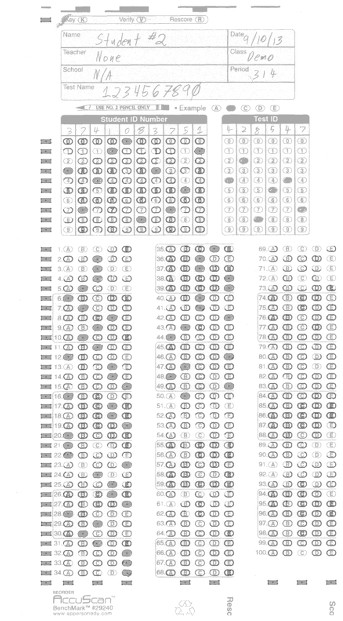A professor encouraged me to write a software implementation of a scantron machine. It's licensed under the ISC or MIT licenses. The goal was to scan a PDF of the key and all the students' sheets, grade, email the students their grade and a copy of their sheet, and then display statistics about the exam. While the program doesn't quite do all that, it does grade scanned forms and provide a website interface for convenience. Feel free to try it out and improve it.
At the moment this only supports one type of form available directly from Apperson or in website/files/form.pdf.
You can either use this as a command-line utility or run it as a daemon providing a website interface.
a C++11 compiler
CppDB (Boost or MIT)
CppCMS (LGPL)
PoDoFo (LGPL)
OpenIL/DevIL (LGPL)
libtiff (custom: http://www.libtiff.org/misc.html)
Note: PoDoFo must be compiled with C++11 not C++98 otherwise it won't extract images. You can modify the CMakeLists.txt file. For Arch, look at my PKGBUILD for podofo-cpp11 and for freetron.
make: make; make install
cmake: cd cmake; cmake .; make; make install
I have tested g++ and clang++ on Linux. For Mac you'll find most of the dependencies in Macports, Fink, Homebrew, or whatever you use, but you'll probably have to build CppCMS and CppDB. On Windows you'll have to build basically all of these.
Note: Use cmake if you want the keys generated on install; otherwise, use make and then generate the keys and put them in /srv/freetron or whatever website directory you choose:
cppcms_make_key --hmac sha256 --cbc aes256 \
--hmac-file website/hmac.txt --cbc-file website/cbc.txt
Website interface: ./freetron --daemon website/
Command line interface: ./freetron -i KeyID form.pdf
Download a computer-generated form or a scanned form created from the Apperson form mentioned above. Below is the output of these two example forms. The first takes about 1 second and the second about 3 seconds on my computer.
$ ./freetron -i 123456789 freetron_example.pdf 2>/dev/null
ID Answers (key first)
123456789 A B C D E A B C D E A B C D E
1233224 A A D D D A B C D E A B B C E
987444 A B C D E E D C B A B C D E D
Scores
987444 40.00%
1233224 66.67%
$ ./freetron -i 1793240 freetron_example2.pdf 2>/dev/null
ID Answers (key first)
1793240 E D B B C A B D C B D A D E E B D C E C A A E C C D C C C E C E E D D A C B E A D E A A A C D A E A
888324401 D D B B C C B D A B D A E E E B D C B C A B E C D D C C E E C D D D A A C A A A D A A B A C D A E A
3741083751 _ C C C B A B D C B C A D D E A D D E A A A E C D D E A C B C E E E D C C E E C C E B A _ E B A E B
Scores
888324401 70.00%
3741083751 52.00%
If you specify the -d option, it'll generate debug images, which allows you to find any problematic bubbles or boxes. Below is the output from the third page of the example scanned form. Note that since OpenIL doesn't allow multi-threading, this greatly extends the run time.
If you run the examples in the website, you get:

If you want to extend or modify this program, this summary of what the different portions do may be useful.
options -- All parameters for the supported style of forms (e.g. bubble aspect ratio)
extract -- Extract the images from the PDF
processor -- Manage the extracting and processing threads, what to do with
each image, etc. Basically, if you want to extend this program, you would add
additional code to the end of parseImage.
read -- Find filled bubbles for the answers, ID, etc. on the form.
rotate -- Determine the rotation from the list of black boxes on the left
and bottom of the form.
blobs -- Connected-component labeling of black objects in image
histogram -- Self explanatory
box -- Taking a starting pixel, determine if the object that point is a
part of is actually one of those black boxes on the left and bottom.
outline -- Contour tracing. Given a starting point, get a vector of points
on the boundary of that object.
boxes -- Find the blobs and determine if each is a box.
forms -- Each form (on the command line you will have only one) stores all
the information needed about it and the individual pages of that form.
pixels -- Data structure for storing pixel data
data -- Data structures for coordinates, answers, etc.
disjointset -- Used in the connected-component labeling.
log -- Log messages will be put at end of output
maputils -- Iterators and whatnot
math -- All the distance, average, stdev, etc. functions
threadqueue(void) -- Run the processing in a number of threads.
cores -- Get the number of cores for determining the number of threads to
use.
The website uses CppCMS, so you may want to become acquainted with that to understand this code.
website -- Main website application
rpc -- Get/set data for Javascript RPC
database -- Manage saving/reading database information using CppDB
date -- Access the date in a thread-safe way
content, skin, *.tmpl, *.js, *.css -- For the page
templates and website design
